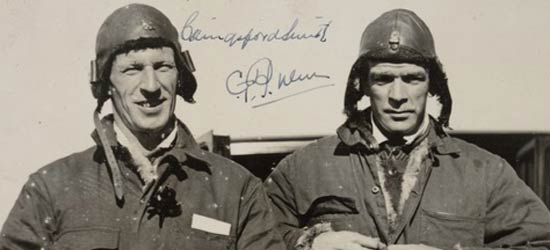"Smithy" and the Southern Cross
Australian aviators Charles Kingsford Smith and Charles Ulm completed the first trans-Pacific flight in 1928. With Americans Harry Lyon and James Warner as navigator and wireless operator, they flew from Oakland, California to Sydney in the Fokker trimotor Southern Cross.
The flight was particularly dangerous and local Californian betting had odds of eleven to one against their even reaching Hawaii, as ten fliers had perished the previous year attempting just the first leg of the Pacific crossing.
Detail from Charles Kingsford Smith and Charles Ulm after the flight, 10 June 1928
Autographed photograph P1/ Ulm, Charles (BM)
The Southern Cross was one of the largest aeroplanes of its time. Purchased second-hand from Australian polar explorer George Hubert Wilkins, it had been salvaged from one of Wilkins' planes called the Detroiter, which crashed in Alaska in 1926. Fitted with three new engines, courtesy of Melbourne businessman Sidney Myer, the rejuvenated craft was bought by the wealthy American aviator G. Allan Hancock and loaned back to Kingsford Smith and Ulm, enabling the journey to take place.
The noise of the three Wright Whirlwind engines was deafening. So much so that the crew were forced to communicate with each other by messages scribbled on scraps of paper. By the time they reached Fiji, the crew were stone deaf and had no idea what the welcoming party said, observing only the waving arms and open mouths of the crowd.
> View the scribbled messages passed between the crew of the Southern Cross
Despite electrical storms, rain squalls, instrument failures and a heart-stopping eight minute engine splutter mid ocean, the Southern Cross and its crew completed the 12,000 kilometre journey in four stages, with a total of 83 hours flying time.
The arrival in Sydney on 10 June 1928 heralded a tumultuous welcome from a crowd estimated at 300,000. A police cordon formed around the plane as it taxied to a halt to prevent the excited crowds from rushing into the propellors.
> View photos of the arrival of the Southern Cross and crew from Charles Ulm's Collection, 1928-1934


